Articles
- Page Path
- HOME > J Korean Acad Nurs > Volume 39(5); 2009 > Article
-
Original Article
- Identification and Validation of Symptom Clusters in Patients with Hepatocellular Carcinoma
- Myung Sook Cho, In Gak Kwon, Hee Sun Kim, Kyunghee Kim, Eunjung Ryu
-
Journal of Korean Academy of Nursing 2009;39(5):683-692.
DOI: https://doi.org/10.4040/jkan.2009.39.5.683
Published online: October 31, 2009
1Associate Professor, Department of Clinical Nursing Science, Samsung Medical Center, Sungkyunkwan University School of Medicine, Seoul, Korea.
2Unit Manager, Department of Nursing, Samsung Medical Center, Seoul, Korea.
3Professor, Department of Nursing, Chung-Ang University, Seoul, Korea.
4Professor, Department of Nursing, Konkuk University, Chungju, Korea.
- Address reprint requests to: Kwon, In Gak. Department of Clinical Nursing Science, Samsung Medical Center, Sungkyunkwan University School of Medicine, 50 Irwon-dong, Gangnam-gu, Seoul 135-710, Korea. Tel: 82-2-3410-2904, Fax: 82-2-3410-6616, ingak.kwon@samsung.com
Copyright © 2009 Korean Society of Nursing Science
Abstract
-
Purpose
- The purpose of this study was to identify cancer-related symptom clusters and to validate the conceptual meanings of the revealed symptom clusters in patients with hepatocellular carcinoma.
-
Methods
- This study was a cross-sectional survey and methodological study. Patients with hepatocellular carcinoma (N=194) were recruited from a medical center in Seoul. The 20-item Symptom Checklist was used to assess patients' symptom severity. Selected symptoms were factored using principal-axis factoring with varimax rotation. To validate the revealed symptom clusters, the statistical differences were analyzed by status of patients' performance status, Child-Pugh classification, and mood state among symptom clusters.
-
Results
- Fatigue was the most prevalent symptom (97.4%), followed by lack of energy and stomach discomfort. Patients' symptom severity ratings fit a four-factor solution that explained 61.04% of the variance. These four factors were named pain-appetite cluster, fatigue cluster, itching-constipation cluster, and gastrointestinal cluster. The revealed symptom clusters were significantly different for patient performance status (ECOG-PSR), Child-Pugh class, anxiety, and depression.
-
Conclusion
- Knowing these symptom clusters may help nurses to understand reasonable mechanisms for the aggregation of symptoms. Efficient symptom management of disease-related and treatment-related symptoms is critical in promoting physical and emotional status in patients with hepatocellular carcinoma.
- 1. Armstrong TS, Cohen MZ, Eriksen LR, Hickey JV. Symptom clusters in oncology patients and implications for symptom research in people with primary brain tumors. Journal of Nursing Scholarship. 2004;36:197–206.ArticlePubMed
- 2. Baeg SU. The choice of hepatocellular cancer treatment. Korean Journal of Hepatology. 2002;8:E57–E65.
- 3. Barsevick AM. The elusive concept of the symptom cluster. Oncology Nursing Forum. 2007;34:971–980.ArticlePubMed
- 4. Barsevick AM, Whitmer K, Sweeney C, Nail N. A pilot study examining energy conservation for cancer treatment related fatigue. Cancer Nursing. 2002;25:333–341.ArticlePubMed
- 5. Bender CM, Ergun FS, Rosenzweig MQ, Cohen SM, Sereika SM. Symptom clusters in breast cancer across 3 phases of the disease. Cancer Nursing. 2005;28:219–225.PubMed
- 6. Cancer Statistics. National Cancer Information Center. 2008;11 13 Retrieved February 20, 2009. from http://www.cancer.go.kr/cms/index.html.
- 7. Chen ML, Tseng HC. Symptom clusters in cancer patients. Support Care Cancer. 2006;14:825–830.ArticlePubMedPDF
- 8. Chun NM, Kwon JY, Noh GO, Kim SH. Symptom clusters in women with gynecologic cancer. Journal of Korean Clinical Nursing Research. 2008;14:61–70.
- 9. Dodd MJ, Miaskowski C, Paul S. Symptom clusters and their effects on the functional status of patients with cancer. Oncology Nursing Forum. 2001;28:465–470.PubMed
- 10. Gaston-Johansson F, Fall-Dickson JM, Nanda J, Ohly KV, Stillman S, Krumm S. The effectiveness of the comprehensive coping strategy program on clinical outcomes in breast cancer autologous bone marrow transplantation. Cancer Nursing. 2000;23:277–285.ArticlePubMed
- 11. Ghany M, Hoofnagle JH. Fauci AS, Braunwald E, Kasper DL, Hauser SL, Longo DL, Jameson JL, . Approach to the patient with liver disease. In: Harrison's principles of internal medicine. 2008;New York, NY, McGraw-Hill Companies. 1918–1923.
- 12. Glover J, Dibble SL, Dodd MJ, Miaskowski C. Mood states of oncology outpatients: Does pain make a difference? Journal of Pain and Symptom Management. 1995;10:120–128.ArticlePubMed
- 13. Honea N, Brant J, Beck SL. Treatment related symptom clusters. Seminars in Oncology Nursing. 2007;23:142–151.ArticlePubMed
- 14. Hwang SS, Chang VT, Kasimis BS. A comparison of three fatigue measures in veterans with cancer. Cancer Investigation. 2003;21:363–373.ArticlePubMed
- 15. Kim H, Lee KH, Kim JC, Chung HY, Yoo HJ, Lee J, et al. Development and validation of Korean Functional Assessment Cancer Therapy-General (FACT-G). The Korean Journal of Clinical Psychology. 2003;22:215–229.
- 16. Kim JR. Gastroenterologic disease. 2000;Seoul, Ilchokak.
- 17. Lang CA, Conrad S, Garrett L, Battistutta D, Cooksley WG, Dunne MP, et al. Symptom prevalence and clustering of symptoms in people living with chronic hepatitis C infection. Journal of Pain and Symptom Management. 2006;31:335–344.ArticlePubMed
- 18. Mundfrom DJ, Shaw DG, Ke TL. Minimum sample size recommendations for conducting factor analyses. International Journal of Testing. 2005;5:159–168.Article
- 19. Sun V, Ferrell B, Juarez G, Wagman LD, Yen Y, Chung V. Symptom concerns and quality of life in hepatobiliary cancers. Oncology Nursing Forum. 2008;35(3):E45–E52.ArticlePubMed
- 20. Sun VC, Sarna L. Symptom management in hepatocellular carcinoma. Clinical Journal of Oncology Nursing. 2008;12:759–766.ArticlePubMedPMC
- 21. Walsh D, Rybicki L. Symptom clustering in advanced cancer. Support Care Cancer. 2006;14:831–836.ArticlePubMedPDF
- 2. Wang SY, Tsai CM, Chen BC, Lin CH, Lin CC. Symptom clusters and relationships to symptom interferences with daily life in Taiwanese lung cancer patients. Journal of Pain and Symptom Management. 2008;35:258–266.ArticlePubMed
- 23. Yount S, Cella D, Webster K, Heffernan N, Chang CH, Odom L, et al. Assessment of patient-reported clinical outcome in pancreatic and other hepatobiliary cancers: The FACT hepatobiliary symptom index. Journal of Pain and Symptom Management. 2002;24:32–44.ArticlePubMed
- 24. Zhu AX. Hepatocellular carcinoma: Are we making progress? Cancer Investigation. 2003;21:418–428.ArticlePubMed
- 25. Zigmond AS, Snaith RP. The hospital anxiety and depression scale. Acta psychiatrica Scandinavica. 1983;67:361–370.ArticlePubMed
- 26. Zubrod CG, Scheiderman MA, Frei E, Brindley C, Lennard G, Shnider B, et al. Appraisal of methods for the study of chemotherapy in man: Comparative therapeutic trial of nitrogen mustard and triethylene thiophosphoramide. Journal of Chronic Diseases. 1960;11:7–33.Article
REFERENCES
Figure & Data
REFERENCES
Citations

- Symptoms and symptom clusters in patients with hepatocellular carcinoma and commonly used instruments: An integrated review
Thitiporn Pathomjaruwat, Yaowarat Matchim, Jane M. Armer
International Journal of Nursing Sciences.2024; 11(1): 66. CrossRef - Symptom clusters and network analysis of patients with intermediate and advanced liver cancer treated with targeted immunotherapy
Mei Chen, Shan Li, Guangzhi Jin, Rui Li, Zhi Qi, Yalun He
Supportive Care in Cancer.2024;[Epub] CrossRef - Anxiety and depression prevalence in digestive cancers: a systematic review and meta-analysis
Mohammad Zamani, Shaghayegh Alizadeh-Tabari
BMJ Supportive & Palliative Care.2023; 13(e2): e235. CrossRef - Symptom Clusters in Patients with Non-Hodgkin’s Lymphoma Receiving Chemotherapy
YuJeong Kim, In Gak Kwon
Asian Oncology Nursing.2022; 22(2): 93. CrossRef - Symptom clusters of ovarian cancer patients undergoing chemotherapy, and their emotional status and quality of life
Kyung-Hye Hwang, Ok-Hee Cho, Yang-Sook Yoo
European Journal of Oncology Nursing.2016; 21: 215. CrossRef - Effects of Acupressure on Fatigue and Depression in Hepatocellular Carcinoma Patients Treated with Transcatheter Arterial Chemoembolization: A Quasi-Experimental Study
Su-Chen Lan, Yueh-E Lin, Shu-Ching Chen, Yu-Fang Lin, Yu-Jen Wang
Evidence-Based Complementary and Alternative Medicine.2015; 2015: 1. CrossRef - Quality of Life in Colorectal Cancer Patients according to the Severity of Symptom Clusters Classification
Gyeonghui Jeong, Kyunghee Kim, Yeunhee Kwak
Asian Oncology Nursing.2014; 14(2): 74. CrossRef - Development and Evaluation of Learning Program for Oncology Unit-based Core Nursing Practice - Outcomes based Cancer Patients Pain Management Learning Program -
Yeon Hee Kim, Young Sun Jung, Soon Haeng Lee, Kyoung Ok Kim, Young Nam Jeong, Hye Ryun Jung, Kyunghee Kim
Asian Oncology Nursing.2013; 13(4): 231. CrossRef - Symptom Clusters and Quality of Life in Korean Patients With Hepatocellular Carcinoma
Eunjung Ryu, Kyunghee Kim, Myung Sook Cho, In Gak Kwon, Hee Sun Kim, Mei R. Fu
Cancer Nursing.2010; 33(1): 3. CrossRef
Characteristics of Participants (N=194)
*Missing value excluded; †Multiple response.
TACE=transcatheter arterial chemoembolization; RFA=radiofrequency ablation; ECOG PS=Eastern Cooperative Oncology Group Performance Status.
Symptom Prevalence and Severity (N=194)
*Symptom severity was computed by averaging the symptom severity scores of those who had one or more symptoms.
Factor Matrix for the Four-factor Model (N=194)
Correlations Matrix among Factors (N=194)
Symptom Scores of Factors by Performance Status and Liver Function (N=194)
ECOG=Eastern Cooperative Oncology Group Performance Status.
Symptom Scores of Factors by Anxiety and Depression (N=194)
*Missing value excluded; †Multiple response. TACE=transcatheter arterial chemoembolization; RFA=radiofrequency ablation; ECOG PS=Eastern Cooperative Oncology Group Performance Status.
*Symptom severity was computed by averaging the symptom severity scores of those who had one or more symptoms.
ECOG=Eastern Cooperative Oncology Group Performance Status.
 KSNS
KSNS
 E-SUBMISSION
E-SUBMISSION
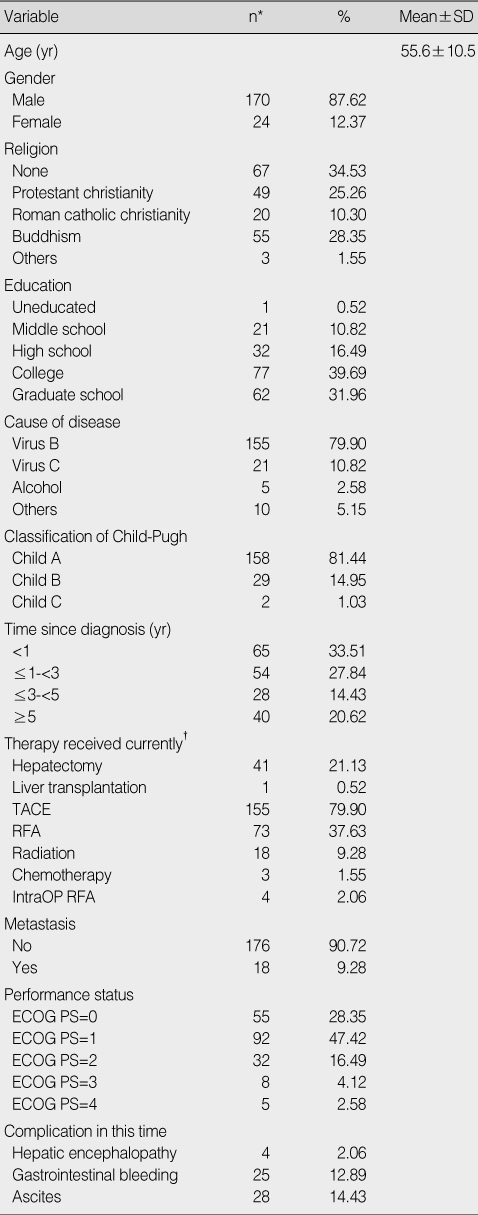
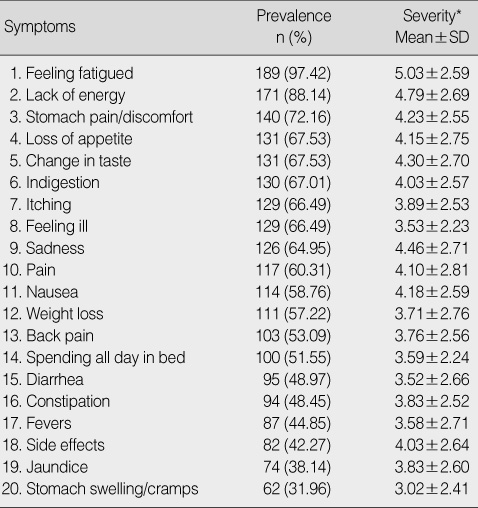
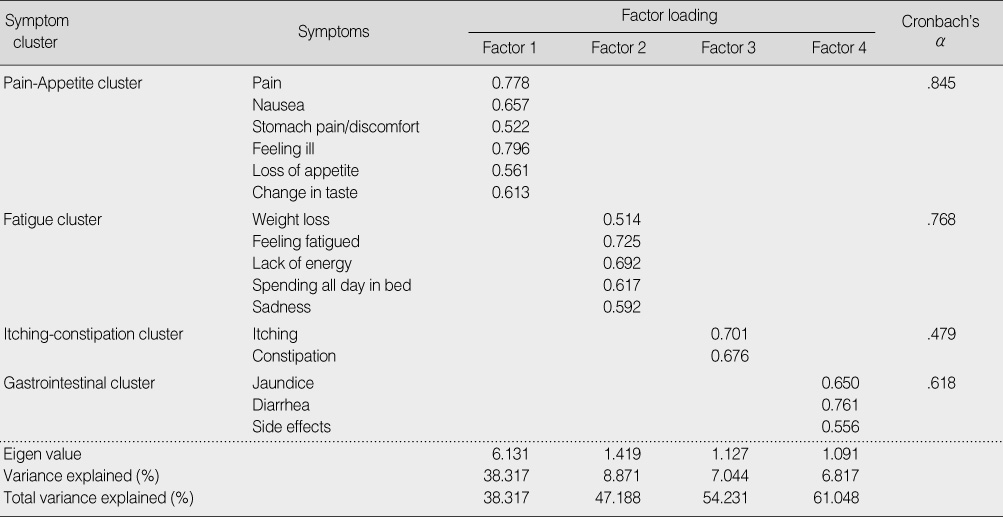

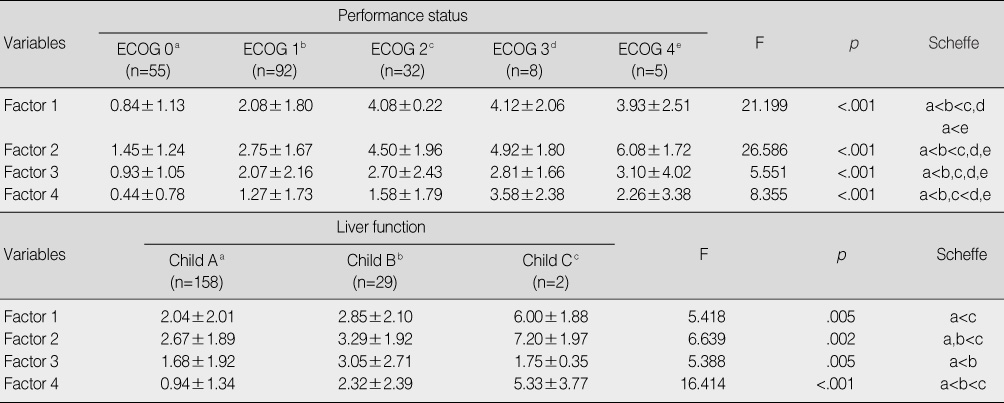
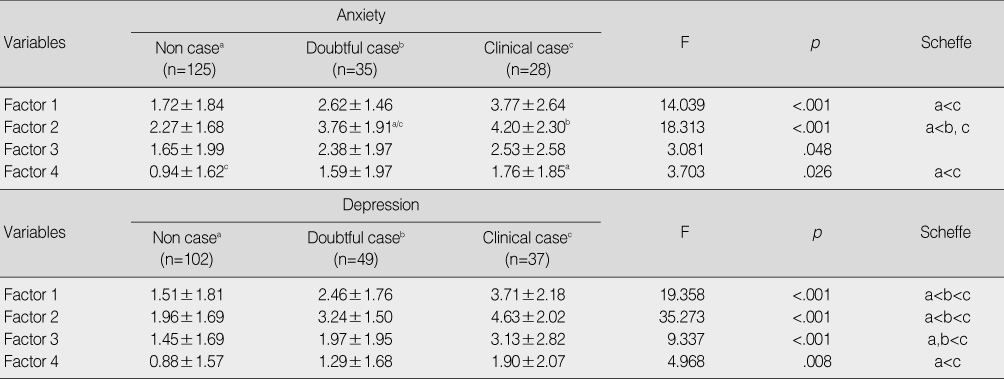
 Cite
Cite

